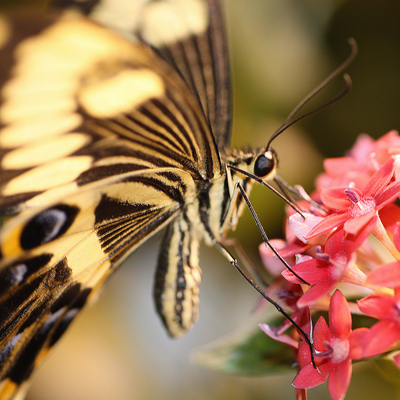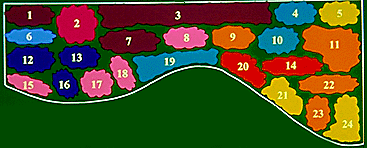Quick facts
- Grow nectar-producing plants that will have flowers in bloom throughout the season.
- Flowers with multiple florets that produce abundant nectar are ideal.
- Provide host plants for the caterpillar forms of butterflies.
- Supplement the garden’s flower nectar with a homemade feeder.
- Avoid the use of broad spectrum pesticides sprayed all around the yard.
Butterfly gardening involves planning your garden to attract, retain and encourage butterfly populations. Flowers of similar colors grouped together are more attractive to both butterflies and the gardener.
Choosing host plants
Select a variety of nectar-producing plants with the aim of providing flowers in bloom throughout the season. This will entice a continuous succession of new visitors to a yard. It is especially important to have flowers in mid to late summer, when most butterflies are active.
- Flowers with multiple florets that produce abundant nectar are ideal.
- Annuals are wonderful butterfly plants because they bloom continuously through the season, providing a steady supply of nectar.
- Butterflies regularly visit perennial plants, such as coneflowers, lilac, butterfly weed and asters.
- Most plants in the mint family are good nectar sources for butterflies.
- Avoid double flowers because they are often bred for showiness, not nectar production.
- Plantings of host plants preferred by butterflies do not require any sacrifice of flowers and colors.
- Plants such as yellow sunflower, pink Joe-Pye weed, purple coneflower and purple verbena, yellow Black-eyed Susan, red bee balm/bergamot and purple wild asters provide plentiful color.
For successful butterfly gardening, you need to provide food for more than the adult butterflies. You need to provide for their caterpillar forms as well.
Butterfly caterpillars have a limited host range. Most caterpillars feed on leaves. Some develop on the reproductive parts of flowers or seeds.
Some supposedly good butterfly plants might not attract butterflies in your garden. It may be that a particular plant is not the preferred larval food of local butterflies.
Common butterflies and their caterpillar food plants
| Butterfly species | Caterpillar food plant |
|---|---|
| Swallowtail Family (Papilionidae) | |
| Black swallowtail | Parsley family - both wild and cultivated: carrot, dill, parsley, parsnip |
| Spicebush swallowtail | Spicebush, sassafras |
| Tiger swallowtail | Aspen, cherry, birch |
| Snout butterfly (Libytheidae) | |
| Common snout butterfly | Hackberry |
| Brush-footed family (Nymphalidae) | |
| Great spangled and idalia fritillary | Violets |
| Buckeye | Plantains, gerardias, toadflax, snapdragons, false loosestrifes |
| Painted lady | Thistles |
| Red admiral | Nettles, false nettle |
| Viceroy and red-spotted purple | Willows, especially black willow, pussy willow, poplars, plums, cherries |
| Hackberry butterfly | Hackberry |
| Monarch butterfly | Milkweeds, butterfly weed |
| Mourning cloak | Willow, birch, aspen, maple, elm |
| Sulphur family (Pieridae) | |
| Common (clouded) sulphur | Clover, alfalfa |
| Dogface butterfly | Lead plant, false indigo, prairie clover |
| Coppers, blues, harvesters, metalmarks families (Lycaenidae, Riodinidae) | |
| American copper | Sorrel |
| Sylvan hairstreak | Willow |
| Common hairstreak | Mallow family, rose & marsh mallows, hollyhock |
| Gray hairstreak | Hawthorn |
| Skipper family (Hesperidae) | |
| Blazing star skipper | Grasses |
Shrubs
Azalea, blueberries, butterfly bush, buttonbush, lilac, privets and sumacs
Cultivated flowers: annuals
Coneflowers, flowering tobacco, impatiens, marigolds, phlox, sunflower and verbena
Cultivated flowers: perennials
Asters, bee balm, butterfly weed, chrysanthemums, daisies, live forever, purple coneflower, sedum and yarrow
Wildflowers
New England aster, bergamots or horsemints, black-eyed Susan, blazing stars, boneset, butterfly flower, coreopsis, ox-eye daisy and purple agertum
Some weedy wildflowers are not appropriate for formal garden settings, but could be used in a wild patch: common milkweeds, dogbane, goldenrods, ironweeds, Joe-Pye weed, nettles and thistles.
Other
Some butterflies, such as the Mourning Cloak (Nymphalidae: Nymphalis antiopa) and Hackberry (Apaturidae: Asterocampa celtis) feed on rotting fruit, sap that oozes from trees, and even dung.
1. Purple coneflower
2. Dill
3. Hollyhock
4. Joe-Pye weed
5. Globe centaurea
6. Peony
7. Turtlehead
8. Swamp milkweed
9. Yarrow
10. Queen Anne’s lace
11. Tawny daylily
12. ‘Marine’ heliotrope
13. Gayfeather
14. Butterfly weed
15. Petunia
16. Mountain bluet
17. Annual aster
18. 'Autumn Joy’ sedum
19. Rock cress
20.French marigold
21. ‘Happy Returns’ daylily
22. Blanket flower
23. Nasturtium
24. Goldenrod
Reduced use of pesticides
One of the most important conservation decisions we can make is to avoid the use of broad spectrum pesticides sprayed all around the yard. Instead, use less harmful spot treatments on plants troubled with pest insects.
For pest insects, use alternative control methods such as oils, soaps and microbial insecticides such as Bacillus thuringiensis (Bt). Remember that oils and soaps still kill caterpillars if sprayed directly on them. They also will die if they feed on plants treated with a Bt formulation that is toxic to them.
Most butterfly species, such as the Tiger Swallowtail (Papilio glaucus), lay only a few eggs at a time. This low level of insect population will not kill shrubs or trees. Black Swallowtail (Papilionidae: Papilio polyxenes) larvae, however, can completely consume herbaceous plants such as dill. To avoid killing a beautiful guest, you should be sure of your identification of an insect as a pest before using any pesticide.
A good side effect of the decrease in pesticide use is the increase of natural enemies. Insects such as spiders, lacewings, ladybird beetles and ground beetles, help to control unwanted pests.
Caution: Mention of a pesticide or use of a pesticide label is for educational purposes only. Always follow the pesticide label directions attached to the pesticide container you are using. Remember, the label is the law.
Enjoy your garden
With a pair of binoculars and a butterfly field guide, your garden is sure to bring you many rewarding hours of butterfly watching. Their daily activities are interesting to watch. Keep a written or photographic record of these special visitors to your garden. Creating your personal Eden is within your grasp.
Reviewed in 2024



